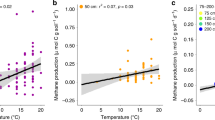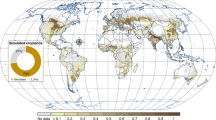Abstract
Simulation experiments have shown that soils can become more acid when treated with accelerated loads of acid precipitation1–3. Field observations, however, give less clearcut answers. Acid deposition is rarely the only variable between sites, and effects are too small for soil pH changes to be measurable over much less than a decade. To circumvent these problems, Hallbacken and Tamm4 in Sweden and Billett et al.5 in Scotland re-sampled soil profiles in forests after 39–57 years and showed that many surface organic and mineral horizons had acidified, but biological acidification and acid deposition may both be implicated in the observed changes5. Here we compare peat acidity and base saturation with modelled acid deposition at 123 sites in Scotland. Peats with highest acidity (pH(CaCl2)≤3.0) and with lowest base saturation (≤10%) are found mainly where deposited acidity was greater than 0.8 kg H+ ha−1 yr−1, providing conclusive evidence that acid deposition plays an important part in the acidification of some soils.
This is a preview of subscription content, access via your institution
Access options
Subscribe to this journal
Receive 51 print issues and online access
$199.00 per year
only $3.90 per issue
Buy this article
- Purchase on Springer Link
- Instant access to full article PDF
Prices may be subject to local taxes which are calculated during checkout
Similar content being viewed by others
References
Abrahamsen, G., Bjor, K., Horntvedt, R. & Tviete, B. in Impact of acid precipitation on forest and freshwater ecosystems in Norway (ed. Brackke, F. H.) 33–63 (F.R. 6/76, Oslo-As, Norway, 1976).
Tamm, C. O. Sveriges SkogsvFor. Tidskr. 75, 189–200 (1977).
Skiba, U. & Cresser, M. S. Wat. Res. (in the press).
Hallbäcken, L. & Tamm, C. O. Scand. J. For. Res. 1, 219–232 (1986).
Billett, M. F., FitzPatrick, E. A. & Cresser, M. S. Soil Use Manage. 4, 102–107 (1988).
Heal, O. W. & Smith, R. A. H. in Production Ecology of British Moors and Montane Grasslands (ed. Heal, O. W. & Perkins, D. F.) 3–16 (Springer, Berlin, 1978).
Derwent, R. G., Dollard, G. J. & Metcalfe, S. E. Q. J. R. met. Soc. 114, 1127–1152 (1988).
UK Review Group on Acid Rain, Acid Deposition in the United Kingdom 1981–1985, Warren Spring Laboratory, Stevenage.
Looney, J. H. H. & James, P. W. in Acid Rain and Britain's Natural Ecosystems (eds Ashmore, M., Bell, N. & Garretty, C.) 13–25 (Imperial College, London, 1988).
Author information
Authors and Affiliations
Rights and permissions
About this article
Cite this article
Skiba, U., Cresser, M., Derwent, R. et al. Peat acidification in Scotland. Nature 337, 68–69 (1989). https://doi.org/10.1038/337068a0
Received:
Accepted:
Issue Date:
DOI: https://doi.org/10.1038/337068a0
This article is cited by
-
Differential Effects of Oxidised and Reduced Nitrogen on Vegetation and Soil Chemistry of Species-Rich Acidic Grasslands
Water, Air, & Soil Pollution (2013)
-
Testate amoeba response to acid deposition in a Scottish peatland
Aquatic Ecology (2010)
-
Ion flux from precipitation to peat soil in spruce forest–Sphagnum bog communities in the Ochiishi district, eastern Hokkaido, Japan
Limnology (2008)
-
Regional nitrogen budgets and riverine N & P fluxes for the drainages to the North Atlantic Ocean: Natural and human influences
Biogeochemistry (1996)
-
Soil chemistry change in a lowland english deciduous Woodland 1974?1991
Water, Air, & Soil Pollution (1995)
Comments
By submitting a comment you agree to abide by our Terms and Community Guidelines. If you find something abusive or that does not comply with our terms or guidelines please flag it as inappropriate.



